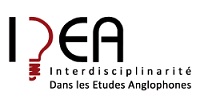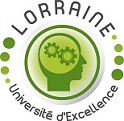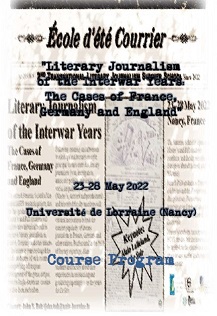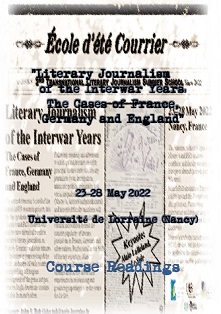Programme > Programme de cours
  
Cliquer sur les liens dessous
Programme en PDF
Lectures des Modules en PDF
 
Programme de l'école d'été
Enseignants :
- John S. Bak, Université de Lorraine, IDEA (UR 2338), France
- Sara Izzo, Universität Bonn, Germany
- Soenke Zehle, Hochschule der Bildenden Künste Saar, Germany
- Hendrik Michael, Otto-Friedrich-Universität Bamberg, Germany
- Tobias Eberwein, Österreichische Akademie der Wissenschaften, Austria
- Sara Prieto, Universidad de Alicante, Spain
- Andrew Griffiths, Open University, England
- Anna Saignes, Université Grenoble Alpes / CNRS, France
Invité professionnel :
Contenu des modules :
Les modules individuels seront enseignés à travers des conférences et des ateliers avec des devoirs de lecture spécifiques sur l’histoire et la fonction du journalisme littéraire, du literary journalism et du literarischer Journalismus par le prisme des huit thèmes cités plus bas. Un projet individuel ou un projet de groupe sera également requis pour la fin de la semaine de cours.
Description des modules de l'école d'été:
Module 1: Großstadtreportagen in der Zwischenkriegszeit aus deutsch-französischer Perspektive│Reportages littéraires des grandes villes pendant l’entre-deux-guerres dans une perspective franco-allemande
Director: Sara Izzo (Languages: Deutsch, Français)
Als Ausdruck einer stetig zunehmenden Urbanisierung ist die Großstadt ein zentraler Topos der literarischen Produktion seit dem Anbeginn der Moderne. Unter der Einwirkung des Ersten Weltkriegs, der ein Zeitalter kriegerischer Kataklysmen einläutet, entwickelt sich die moderne Metropole immer mehr zu einem sozialen und ethnischen Spannungsfeld. Dies zeigt sich auch in den literarischen Reportagen der Zwischenkriegszeit, in denen journalistische Flaneure sowie rasende und reisende Reporter den urbanen Raum der modernen Großstadt kartieren. Dieser ist durch seine multisoziale und -ethnische Ordnungsstruktur gekennzeichnet, welche sich beispielsweise in den Gegenüberstellungen von florierendem Stadtzentrum und proletarischen Wohnvierteln am Stadtrand oder parallelen Gesellschaften im Untergrund widerspiegeln. Die Armut ist in Form von Massenarbeitslosigkeit, Elend, Kriminalität und Migration in die Stadtbilder eingeschrieben. Aus einer komparatistischen Perspektive sollen in diesem Modul die literarisch-journalistischen Großstadtbilder insbesondere von Berlin, Marseille und Wien im Kontext der schwelenden sozialen und politischen Krise der 1920/30er Jahren in den Blick genommen werden. Als Grundlage dienen die Reportagen über Berlin von Pierre Mac Orlan und Egon Erwin Kisch, über Marseille von Albert Londres und Jospeh Roth sowie über Wien von Else Feldmann, die in Hinblick auf ihre spezifischen Darstellungsmodi sozialkritischer Stadtraumbeschreibungen analysiert werden.
Comme expression d’une urbanisation constamment croissante, la grande ville est une topique significative de la production littéraire depuis les origines de l’ère moderne. Sous l’impact de la Première Guerre mondiale, qui a sonné l’avènement d’une ère des cataclysmes guerriers, les métropoles modernes se transforment en champ de tension socio-ethnique. Ce développement se manifeste dans les reportages littéraires produits dans l’entre-deux-guerres, dans lesquels des ‘flâneurs–journalistes’, des ‘reporters sémillants’ ou simplement des reporters–voyageurs cartographient l’aire urbain de la métropole moderne. L’espace urbain se caractérise par une structure d’organisation multi-sociale et -ethnique, qui s’exprime par exemple par une mise en opposition du centre–ville florissant et prospère et des quartiers sensibles ou prolétaires à la périphérie ainsi que par des sociétés parallèles souterrains. La pauvreté s’inscrit dans les images des grandes villes par le chômage de masse, la misère, la criminalité ou la migration. Dans ce module, seront mis en lumière, d’une perspective comparatiste, les images des métropoles allemandes, autrichiennes et françaises – Berlin, Marseille et Vienne – dans le contexte de la crise larvée des années 1920 et 1930. Les reportages sur Berlin de Pierre Mac Orlan et d’Egon Erwin Kisch, sur Marseille de Albert Londres et de Joseph Roth, et sur Vienne d’Else Feldmann nous serviront de base à l’analyse de la construction narrative de l’espace urbain dans le journalisme littéraire de l’entre-deux-guerres.
Module 2: Journalism as Space of Appearance: Documentary Aesthetics in the Inter-War Years│Journalismus als Erscheinungsraum: Dokumentarische Ästhetiken in der Zwischenkriegszeit
Director: Soenke Zehle (Languages: English, Deutsch)
This module will look at the intersections between literary journalism and other aesthetic practices that engage with questions of documentation, reportage, and witnessing. With a particular focus on experimental theater exploring new forms of engagement with historical conditions, the module will tease out the elements of a documentary aesthetic shared across these practices, and assess their contemporary resonances and relevance.
Diese Modul widmet sich den Beziehungen zwischen literarischem Journalismus und anderen ästethischen Praktiken, die. sich mit Fragen des Dokuments, der Reportage und der Zeitgenossenschaft auseinandersetzen. Ein besonderer Schwerpunkt liegt auf experimentellen Formen des Theaters auf der Suche nach neuen Formen der Mitgestaltung gesellschaftlicher Rahmenbedingungen. Ziel ist es, die Elemente einer dokumentarischen Ästhetik herauszuarbeiten, die diesen Praktiken gemeinsam ist, und ihre aktuelle Relevanz und Resonanz einzuschätzen.
Module 3: War Chronicles Written by Women: American Reporters from the Western Front│Crónicas de guerra escritas por mujeres: Reporteras norteamericanas desde el Frente Occident
Director: Sara Prieto (Languages: English, Español)
This module will address examples of literary journalism produced by several American women writers who worked as war correspondents at the Western Front during World War I. These authors were lured into the possibility of being eyewitnesses to the war, and into the possibility of exploring a rhetorical territory that had been traditionally forbidden to them. Their experience at the front would allow them to write about the war with a different perspective to the one offered by the official reporters and correspondents. In this module, we will address the journalistic, rhetorical and literary strategies that authors such as Mary Boyle O’Reilly, Mabel Potter Daggett, Mary Roberts Rinehart or Edith Wharton employed to build their own war stories for the American nation.
Este modulo abordará el estudio del periodismo literario de varias autoras estadounidenses que ejercieron como cronistas de guerra desde el frente occidental durante la Primera Guerra Mundial. Estas autoras se sintieron atraídas por la posibilidad de ver la guerra en primera persona, así como por la posibilidad de adentrarse en territorios retóricos tradicionalmente vedados para ellas. Su experiencia en el frente les brindaría la posibilidad de escribir sobre la guerra con una perspectiva diferente a la ofrecida por los cronistas y reporteros oficiales. En este modulo analizaremos las estrategias periodísticas, así como las retóricas y literarias, a las que recurrieron autoras tales como Mary Boyle O’Reilly, Mabel Potter Daggett, Mary Roberts Rinehart o Edith Wharton para construir sus historias de guerra para la nación americana.
Module 4: Das Tage-Buch und Die Weltbühne: Rundschauzeitschriften in der Weimarer Republik und im Exil │ Das Tage-Buch and Die Weltbühne: Highbrow Weeklies in the Weimar Republic and in Exile
Director: Hendrik Michael (Languages: Deutsch, English)
Das Tage-Buch und Die Weltbühne gelten bis heute als einflussreichste Rundschauzeitschriften der Weimarer Republik. In ihnen wurden aktuelle Themen aus Politik, Wissenschaft und Kultur aufgegriffen und durch interkulturelle Bezüge verknüpft. Ihre politische Ausrichtung war entschieden liberal und pazifistisch. Sie widersetzten sich damit dem zunehmend antidemokratischen und repressiven Meinungsklima, das in anderen Medien und der Öffentlichkeit immer stärker vorherrschte. Als Dokumente der Zeitgeschichte helfen sie uns den Verbindungslinien zwischen Journalismus und Literatur nachzuspüren, die Rolle kritischer Publizistik in unsicheren Zeiten zu diskutieren sowie unterschiedliche Möglichkeiten der Zeit- und Kulturkritik in den Zwischenkriegsjahren und nach der Machtergreifung der Nationalsozialisten auszuloten. Das Modul verfolgt drei Ziele: Erstens, die Herausgeber und Autoren vorzustellen, eine Abgrenzung beider Publikationen von anderen Formen des Kulturjournalismus vorzunehmen sowie allgemein die Veränderungen im Mediensystem der Zwischenkriegsjahre darzustellen. Zweitens, einen Überblick der vielfältigen Themen und Darstellungsformen zu bieten und Formen des literarischen Journalismus zu identifizieren. Drittens, die riskanten Umstände des journalistischen Arbeitens nicht nur in der Endphase der Republik, sondern vor allem in der Exilpresse in Frankreich nachvollziehbar zu machen.
Das Tage-Buch and Die Weltbühne are still considered among the most influential highbrow weeklies of the Weimar Republic. These publications covered a range of topics from politics, science, and culture and framed them in an intercultural context. Their political stance was decidedly liberal and pacifist. Thereby, they opposed an increasingly anti-democratic and repressive climate of opinion that was dominating other media and the public. As historical sources, both publications help us to trace the connections between journalism and literature, discuss the role of critical media in unsteady times, and explore the options to voice cultural critique during the interwar period but especially after Hitler’s seizure of power. The module’s goals are threefold: first, provide biographical background about the editors and authors of both journals, differentiate both publications from competing forms of cultural journalism, and outline the transformations of the German media system during this period; second, survey the different topics and genres that were published in Das Tage-Buch and Die Weltbühne in order to identify forms of literary journalism; and third, comprehend the perilous circumstances of journalistic work – not only in the final phase of the republic, but especially as press emigré in France.
Module 5: The Rise and Fall of the Literary Reportage in the Interwar Period: The Case of Joseph Roth │ Aufstieg und Fall der Literarischen Reportage in der Zwischenkriegszeit – am Beispiel von Joseph Roth
Director: Tobias Eberwein (Languages: English, Deutsch)
Hardly any proponent of German-language journalism offers better proof of the appeal of Literary Reportage than the “Jahrhundertschriftsteller” of Joseph Roth. Born in 1894 in Galician Brody, reaching highest esteem in Vienna and Berlin, before dying in Parisian exile in 1939, the restless writer left us a journalistic oeuvre of twenty active years that covers more than 3,000 book pages. This module will analyze selected textual examples and put them in a biographical and historical context – thus illustrating how the genre of Literary Reportage reached an impressive bloom in the interwar period, which experienced a quick downfall after Hitler’s “Machtergreifung.”
Kaum ein Vertreter des deutschsprachigen Journalismus verkörpert die Strahlkraft der Literarischen Reportage so sehr wie der “Jahrhundertschriftsteller” Joseph Roth. 1894 im galizischen Brody geboren, in Wien und Berlin zu höchstem Ansehen gekommen und 1939 im Pariser Exil verstorben, hat der rastlose Schreiber während seiner kaum 20-jährigen Schaffenszeit ein journalistisches Werk hinterlassen, das mehr als 3.000 Buchseiten füllt. Das Modul ordnet ausgewählte Textbeispiele in einen biografischen und zeitgeschichtlichen Kontext ein – und veranschaulicht damit, wie das Genre der Literarischen Reportage in der Zwischenkriegszeit eine imposante Blütezeit durchlebte, die nach der ‘Machtergreifung’ durch Hitler einen schnellen Niedergang erlebtej.
Module 6: British War Correspondence and Literary Journalism, 1914-1918
Director: Andrew Griffiths (Language: English)
This module examines war correspondence in the British press from 1914-1918, exploring the relationship between that correspondence and the emerging tradition of literary journalism. The focus of the module will be on the ways in which the most successful war correspondents used literary technique to provide meaningful reportage, despite the significant restrictions placed on their work. As war correspondent Philip Gibbs once acknowledged, critical responses during and after the war damned the output of British war correspondents as a continuation of an obsolete Victorian mode of reportage, as unalloyed propaganda, and as generally inadequate to the task of representing the war. The module will ask how well founded these criticisms are, and in what ways selected British war correspondence of World War I can be considered a part of the history of literary journalism. In order to answer these questions, the module will take a long view, outlining the stylistic roots of World War I correspondence in Victorian and Edwardian journalistic practice, the conditions under which journalists worked during the war, and the ways in which World War I correspondence continued to resonate in British culture after the war. Selected texts, both journalistic and critical, will be examined in detail to inform scholarly debate.
Module 7: Hollywood et le reportage dans les années 1930
Director: Anna Saignes (Language: Français)
Hollywood et le reportage ont partie liée. La vie secrète des stars a fait – et continue à faire – le succès d’un certain nombre de magazines. À première vue cependant, le reportage people ne semble pas présenter de lien avec le reportage au sens noble du terme, animé par un souci de vérité et d’engagement politique aux côtés de ceux qui souffrent. Comment expliquer alors l’attirance du reportage littéraire pour Hollywood, avec ses faux-semblants et ses artifices ? En effet, dans les années 1930, alors même que le genre connaît son âge d’or, les reportages sur Hollywood se multiplient au point de former un véritable sous-genre, illustré par Blaise Cendrars et Joseph Kessel en France, par Egon Erwin Kisch dans le domaine germanophone, par Aleksander Janta-Połczyński en Pologne, ou encore le franco-russe Vladimir Pozner, parmi bien d’autres. Comment expliquer que les reporters qui se rendent dans les foyers pour sans-abris et sur les lignes de front font également halte à Hollywood ? Nous explorerons différentes réponses possibles à la question des enjeux d’Hollywood dans le reportage des années 1930 et au-delà : phénomène de mode, fascination pour une forme par excellence de la modernité, affinités formelles (le montage), aspiration à traverser les apparences pour atteindre le vrai, ou encore lieu où l’écrivain-reporter négocie sa posture entre celle de l’artiste et celle de l’homme des médias.
Module 8: Soldier Trench Journals from WWI: British, French and German Literary War Journalism │ Les journaux des tranchées de soldats de la Première Guerre mondiale : Le journalisme littéraire de guerre britannique, français et allemand
Director: John S. Bak (Languages: English, Français)
Trench journals – soldier newspapers or unit magazines which intermix serious journalism, poetry and satirical cartoons with sports reports and other troop persiflage – were produced by and for the various regiments of nearly all the nations participating in the war. Published weekly or monthly or whenever lulls in the fighting were long enough to allow for their production, the periodicals vary in length and professionalism, from the early handwritten and purple-ink journaux des tranchées in France of four pages, to the professionally typeset and printed Schützengrabenzeitungen in Germany (or German-occupied territories) that ran from eight to sixteen pages. Nearly every regiment had its own trench newspaper, which was used as a way to raise morale among the troops and to diffuse to the home front the stories left untold in the censored and jingoistic press. This module’s goal is twofold: first, to explore the manner in which narrative news reporting, particularly at traumatic times, is often privileged over hard news reporting due to its ability to help heal the writer and soothe the reader, a phenomenon often experienced with literary journalism later in the 20th century; and second, to determine whether or not the nonfiction pieces produced within these trench journals represent early literary journalistic styles of their respective nations, be it the local color sketches and columns of the North American press, or the literary dispatches of European reportage.
Des journaux de tranchées – journaux ou magazines écrits et édités par les soldats eux-mêmes qui mêlent le journalisme sérieux, la poésie et les caricatures satiriques à des reportages sportifs et autres persiflages de troupes – ont été produits par et pour les divers régiments de presque toutes les nations participant à la Grande Guerre. Publiés chaque semaine, chaque mois, ou chaque fois que les accalmies dans les combats étaient suffisamment longues pour permettre leur production, les périodiques varient en longueur et en professionnalisme, des premiers journaux français écrits à la main en quatre pages et à l’encre violette, à des Schützengrabenzeitungen allemands de huit à seize pages imprimées professionnellement. Presque chaque régiment avait son propre journal de tranchées, qui servait à remonter le moral des troupes et à diffuser derrière le front les nouvelles des troupes laissées inaperçues dans la presse censurée et chauviniste. Ce module a un double objectif : premièrement, explorer la manière dont le reportage narratif, en particulier à des moments traumatisants, est souvent privilégié par rapport au récit historique en raison de sa capacité à aider à guérir l’écrivain et à apaiser le lecteur, un phénomène souvent trouvé dans le journalisme littéraire plus tard au XXe siècle ; et deuxièmement, déterminer si les récits non fictionnels produits dans ces journaux de tranchées représentent les premiers styles journalistiques littéraires de leurs pays respectifs.
|







